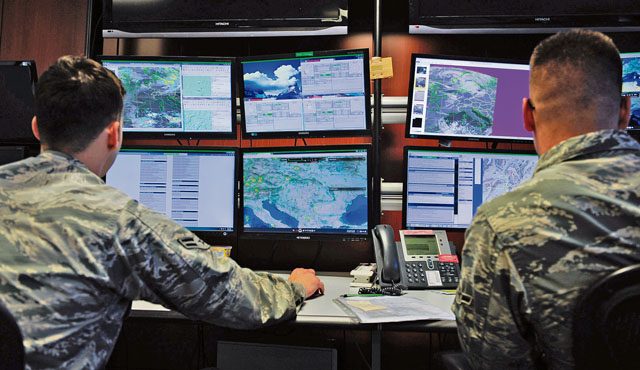
Walking outside and seeing clouds or an incoming storm can incite different reactions. Some dread the stormy weather, while others enjoy it. Sometimes the weather isn’t always an important part of a particular mission, so people won’t think too much about a storm.
Airmen assigned to the 21st Operational Weather Squadron are constantly watching the weather to ensure service members within the U.S. European Command and the U.S. Africa Command can perform their duties in spite of the conditions.
“Our responsibility is to characterize the environment for our customer in conjunction with resource protection, forecasting and flight weather briefs,” said Senior Master Sgt. Jacob Arfa, squadron operations superintendent. “This is so that our customers can take that information and exploit it in the execution of a mission.”
One of the squadron’s missions is to ensure that aircrews know the weather conditions or any other possible weather related hazards. When a pilot submits a request for a flight weather brief, ground sensing stations that are only found at airports and military installations sense and record all atmospheric conditions, such as temperature, air pressure and wind speeds.
From the moment a pilot leaves the ground to landing at their final destinations, the weather conditions can greatly affect their mission. Each report is specifically tailored to every individual mission, ensuring that pilots are fully prepared before flying.
The Airmen at the 21 OWS are no strangers to teamwork, as the wingman concept is often ingrained into every one of us. But the Airmen also have an opportunity others may not get to experience; teamwork between military branches.
For the past 11 years, the squadron has worked side by side with the U.S. Navy Fleet Weather Center Aviation Detachment. Sharing the same equipment and professionalism between the two branches has only improved the unit’s efficiency.
“The professional development that my guys get from the Sailors is something they would never get anywhere else, because they work so closely with their naval counterparts,” Arfa said.
The Sailors are trained and qualified to the same standard for the same mission as the Airmen, and together give over 1200 flight weather briefs per month.
“There’s no differentiating what a Sailor or an Airman learns while on the watch,” said U.S. Navy Chief Petty Officer Annalyn Lawe, U.S. Navy Fleet Weather Center Aviation Detachment leading Chief Petty Officer. “It’s important that we communicate the differences (in branches) so that we can accurately put out products to the customers we are tailoring them for.”
One of the most recent exercises that the 21 OWS and the Fleet Weather Center Aviation Detachment has helped to orchestrate was Exercise Anakonda; an exercise that conducted complex training events back in June to help interoperability between approximately 24 nations.
During Exercise Anakonda, the 21 OWS and the Fleet Weather Center Aviation Detachment provided resource protection to 17 sites in Poland.
Every day, position forecasters, contingency forecasters, synopticians and flight weather briefers continue to work hard and ensure Airmen are able to perform their missions despite any weather.


